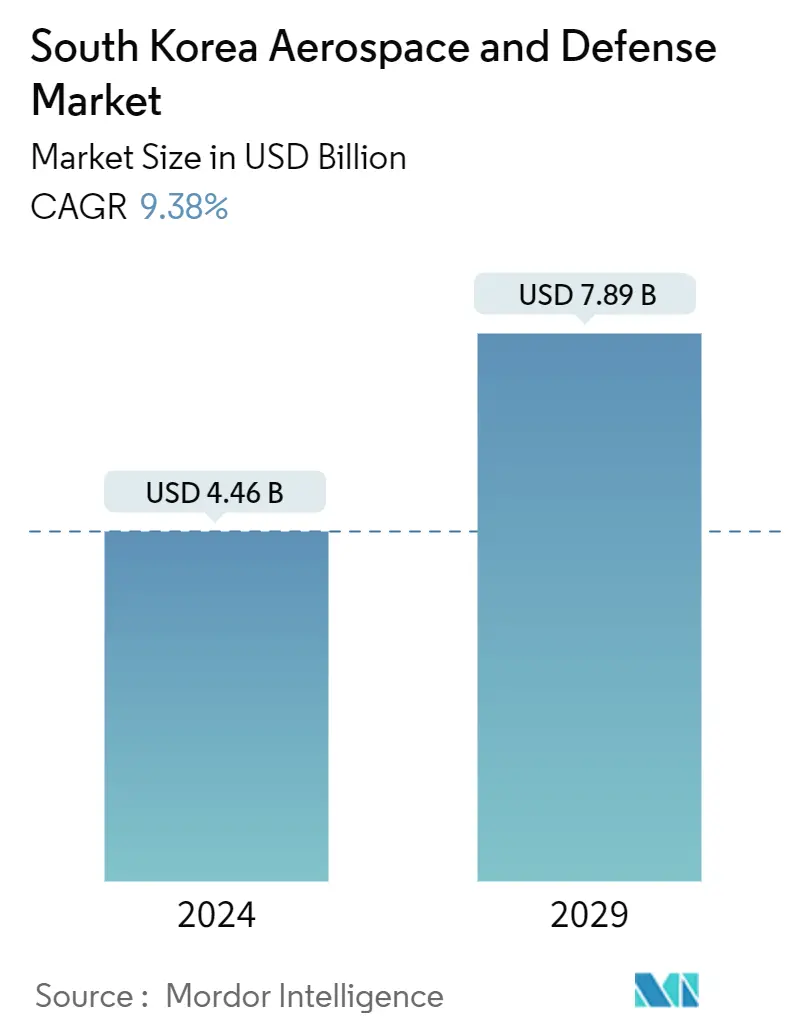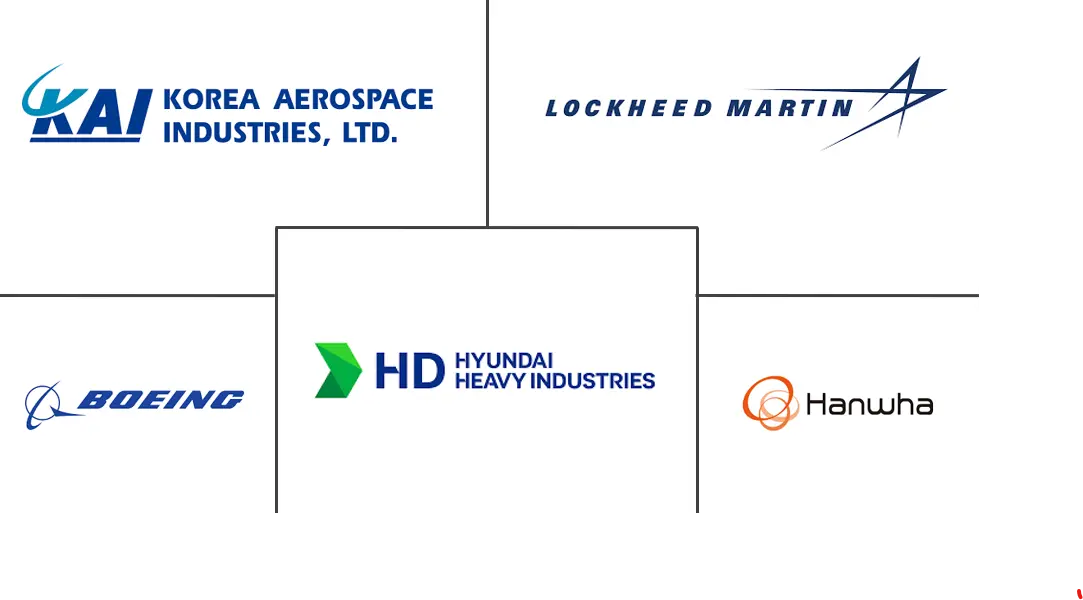Market Size of South Korea Aerospace And Defense Industry

| Study Period | 2019 - 2029 |
| Base Year For Estimation | 2023 |
| Market Size (2024) | USD 4.46 Billion |
| Market Size (2029) | USD 7.89 Billion |
| CAGR (2024 - 2029) | 9.38 % |
| Market Concentration | Medium |
Major Players
*Disclaimer: Major Players sorted in no particular order |
South Korea Aerospace and Defense Market Analysis
The South Korea Aerospace And Defense Market size is estimated at USD 4.46 billion in 2024, and is expected to reach USD 7.89 billion by 2029, growing at a CAGR of 9.38% during the forecast period (2024-2029).
The South Korean air transport industry stands out globally for its efficiency, showing consistent and robust growth. This growth has been propelled by escalating air traffic, substantial investments in airport infrastructure, and a rising appetite for new commercial aircraft.
In 2023, the South Korean government allocated approximately USD 47.9 billion to its defense, marking a 1.1% uptick from the previous year and a significant 34% surge over the decade from 2014 to 2023. Notably, in its 2022–2026 mid-term defense strategy, the Ministry of National Defense bolstered this commitment, pushing the defense budget to USD 271.5 billion. Heightened security concerns emanating from North Korea and escalating conflicts in neighboring Asian nations have underscored the imperative for South Korea to fortify its defense capabilities.
Investments in cutting-edge technologies further fuel anticipated market growth. These investments are geared toward enhancing the lethality, precision, and range of weaponry, bolstering communication capabilities, and providing advanced services to counter swiftly evolving threats.
Conversely, as global attention shifts toward environmental concerns and governmental bodies and defense agencies grapple with the need to curtail their greenhouse gas emissions, this environmental imperative could pose a challenge, potentially impacting the expansion of terrestrial and aerial military fleets in the coming years.
South Korea Aerospace and Defense Industry Segmentation
The South Korean aerospace and defense market mainly comprises companies that manufacture products for military use. International collaborations, partnerships, weapon and defense asset developments, space programs, and other important factors impact the South Korean defense and aerospace market.
The South Korean aerospace and defense market is segmented by industry and type. By industry, it is segmented into manufacturing, design, and engineering and maintenance, repair, and overhaul. By type, it is segmented into aerospace and defense. For each segment, the market sizing and forecasts have been provided based on value (USD).
| Industry | |
| Manufacturing, Design, and Engineering | |
| Maintenance, Repair, and Overhaul |
| Type | |||||
| |||||
|
South Korea Aerospace And Defense Market Size Summary
The South Korean aerospace and defense market is poised for significant growth, driven by robust developments in both air transport and defense sectors. The air transport industry in South Korea is recognized globally for its efficiency and is experiencing consistent expansion due to increasing air traffic, substantial investments in airport infrastructure, and a growing demand for new commercial aircraft. Major airlines are actively investing in revitalizing their fleets to meet the rising passenger and cargo transport needs, with significant procurements and partnerships underway. Meanwhile, the defense sector is witnessing a surge in budget allocations, reflecting heightened security concerns and the need to enhance military capabilities. Investments in advanced technologies are aimed at improving weaponry precision, communication systems, and overall defense readiness, despite environmental challenges that may impact military fleet expansion.
The satellite manufacturing industry in South Korea has emerged as a significant player in the global space sector, supported by substantial investments in research and development. The Korea Aerospace Research Institute (KARI) plays a pivotal role in advancing satellite technologies, contributing to the country's growing capabilities in high-resolution imaging, remote sensing, and satellite communication systems. The market is characterized by a semi-consolidated structure, with key players like Lockheed Martin, Korea Aerospace Industries, and Boeing investing in technologically advanced products to meet both national and international demands. The focus on indigenous production and strategic collaborations is expected to drive further growth, supported by large-scale domestic and foreign investments.
South Korea Aerospace And Defense Market Size - Table of Contents
-
1. MARKET DYNAMICS
-
1.1 Market Overview
-
1.2 Market Drivers
-
1.3 Market Restraints
-
1.4 Porter's Five Forces Analysis
-
1.4.1 Threat of New Entrants
-
1.4.2 Bargaining Power of Buyers/Consumers
-
1.4.3 Bargaining Power of Suppliers
-
1.4.4 Threat of Substitute Products
-
1.4.5 Intensity of Competitive Rivalry
-
-
-
2. MARKET SEGMENTATION
-
2.1 Industry
-
2.1.1 Manufacturing, Design, and Engineering
-
2.1.2 Maintenance, Repair, and Overhaul
-
-
2.2 Type
-
2.2.1 Aerospace
-
2.2.1.1 Space
-
2.2.1.2 Civil Aviation
-
-
2.2.2 Defense
-
2.2.2.1 Army
-
2.2.2.2 Navy
-
2.2.2.3 Air Force
-
-
-
South Korea Aerospace And Defense Market Size FAQs
How big is the South Korea Aerospace And Defense Market?
The South Korea Aerospace And Defense Market size is expected to reach USD 4.46 billion in 2024 and grow at a CAGR of 9.38% to reach USD 7.89 billion by 2029.
What is the current South Korea Aerospace And Defense Market size?
In 2024, the South Korea Aerospace And Defense Market size is expected to reach USD 4.46 billion.

